Water/Wet/Liquid/Fluid-HCI/UI DECONference 2003 (March 21st - May 29),
submission to Roger F. Malina, Leonardo, 12 August 2003.
Telematic Tubs against Terror:
Bathing in the Immersive Interactive Media of the Post-Cyborg Age
Steve Mann
August 12, 2003
Abstract
This article reports on what we believe was the world's first shared
Water/Wet/Liquid/Fluid-HCI/UI (Human-Computer/User-Interface)
underwater VR (virtual reality) and BCI (Brain-Computer Interface)
web-based shared immersive multimedia experience,
which I have named "Telematic Tubs".
Telematic Tubs consisted of a network of bath tubs / hot tubs / float tanks
equipped with webcams, computers, and web browsers, to create interactive
shared communal bathing spaces that explored the relationship between
public and private space. Some of the tubs also included
other sensors such as ECG (heart) and EEG (brainwaves)
so that the communal bath environment interactively encompassed both
the body and the mind.
Some of the communal bathing events that took place included
an interactive brainwave jazz performance ("music in the
Key of EEG"), as well as the "optical erection"
(a visual involuntary indicator of arousal computed through
brainwave surveillance and displayed upon each bather in
response to the visual stimulus they receive when seeing other bathers).




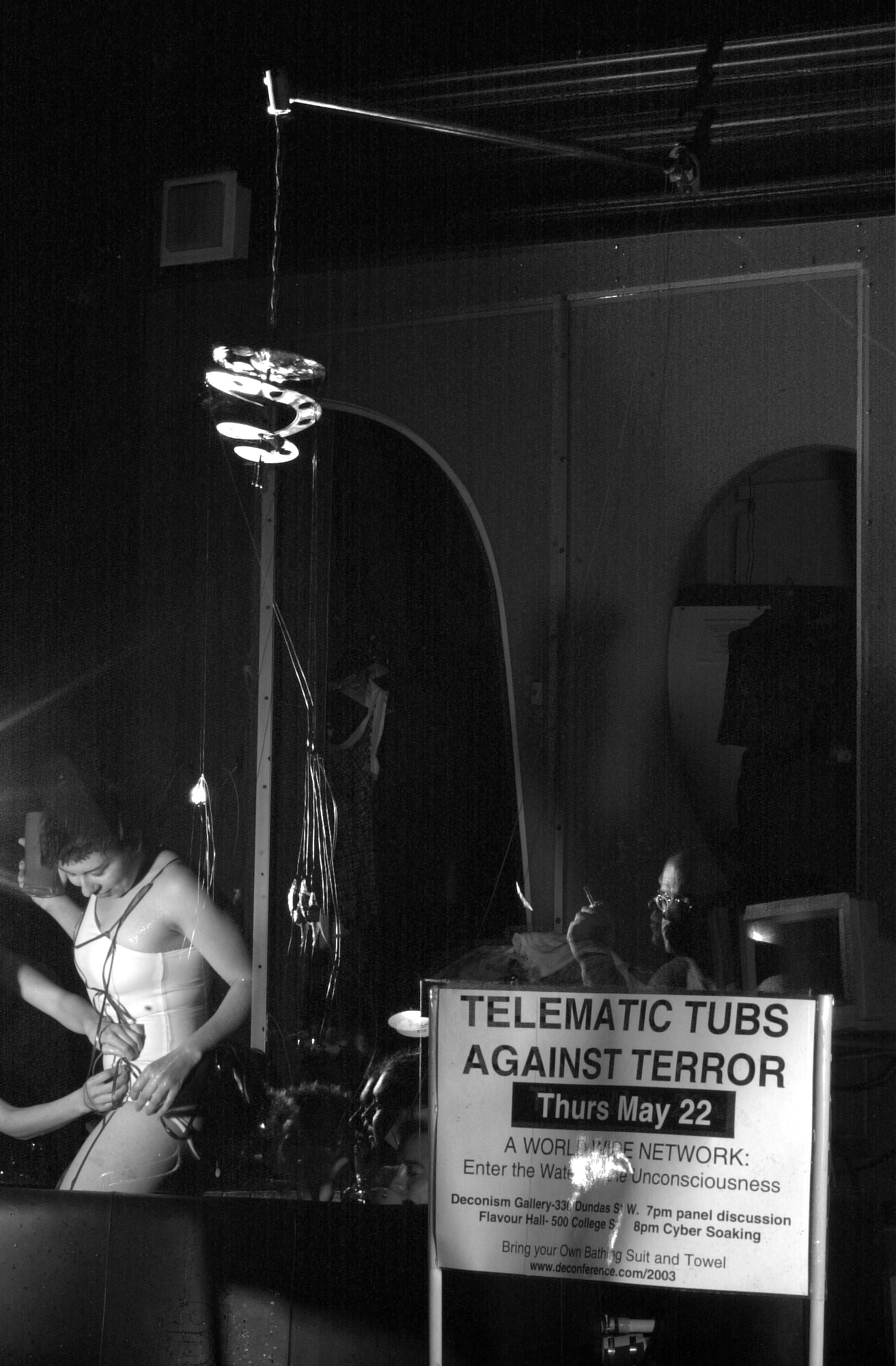
Caption: Float tanks / hot tubs / baths with underwater VR (Virtual Reality)
displays and underwater BCIs (brain-computer interfaces) at separate
geographic locations allow real-time closed-loop cybernetic feedback between
disarate bathers at DECONference 2003. We believe this may be the world's
first example of collaborative / shared
web-based Water/Wet/Liquid/Fluid-HCI/UI with underwater VR+BCI.
Fourth picture in this row of 5 was contributed by Kent Nickerson.
Introduction:
Private/Public Baths, Communal Isolation, and
Quarantine Concentration
The taboo of sex has largely been left behind as popular television
shows take us behind bedroom doors. Yet the bathroom remains as
the final frontier of privacy. In a previous article [1] I explored
surveillance of the bathroom. Not the voyeuristic toiletcams,
or management's hidden cameras in the employee bathrooms, but,
rather, the ubiquitous computing and commonly accepted
telematics of the all-seeing electronic eyes that allege to
be "here to help us, not hurt us". This technology appears
to be on the verge of an evolution toward infrared sensor arrays
connected to remote computer vision systems that might promise
more than merely automatic flushing, but also
to make the bathroom a safer cleaner place, where someone might
come to the rescue if we slip and fall on the bathroom floor,
or save us from drowning if
we fall asleep and sink down into the bathtub.
I have also explored the privacy of the shower and
the return of mandatory communal showers and mass washdowns
brought on by so-called "Emergency Preparedness" [2].
Recently, for example, police have been advised of the
need to prevent people from leaving an area until their
clothing, jewellery, and personal effects have been taken
from them:
Civilians caught in a chemical, biological or nuclear strike area
could face "unsavoury" action as police battle to maintain order,
officers' representatives have warned.
The Police Federation annual conference in Blackpool was told "very
unsavoury, but necessary" action could be needed to control crowds
because of a shortage of officers trained to deal with an
unconventional attack.
Bob Elder, chairman of the constables' central committee, said the
government had not made clear how important it would be to keep the
public inside a cordon after an attack.
...
He added: "The natural reaction from the public caught up in such an
incident will be to get as far away from the scene as possible."
"This could, of course, only extend the problem."
"There may well have to be some very unsavoury but necessary decisions
taken in controlling an infected area."
...
"They must understand that in the event of such a terrible incident
they may be forced to remain in an infected area so as to ensure
containment."
...
Home Office officials have said in the event of an attack, the area
immediately surrounding the scene, known as the "hot zone", would have
an inner and outer cordon, with mobile shower units.
Police would stop anyone leaving the hot zone until they had stripped
and been decontaminated.
[3]
Moreover, with the threats of communicable diseases, the horrors of
mass evacuation, mass stripdowns, and mass detention are all too eminent:
FOR want of something better, the three foreclosed ferryboats anchored
off the city's port can be an ideal quarantine station for the moment.
There is the initial proposal to use an abandoned building at the
Zamboanga City Medical Center as a quarantine station.
...
The Mindanao Sanatorium could be another choice. Its positive factor
is that it has medical faculties and used to isolation practices as in
the treatment of its Hansen patients or lepers.
...
There are even
soldiers assigned there who can be ordered to shoot down any Sars
infected victim who might try to escape the quarantine.
...
In short our authorities must convert it into a floating hospital for
the city and the region.
[4]
Four new detention camps were recently established in China, and a
more permanent detention facility was built in only eight days:
Beijing (AP) - Beijing didn't have enough beds for SARS patients in
its hospitals, so it built a new one - in eight days.
... construction workers put
the finishing touches Wednesday on the new 1,000-bed facility.
... ringed by a 15-foot-high red brick wall ...
The facility is made of prefabricated panels. At the gate, two dozen
members of the paramilitary People's Armed Police stood guard, dressed
in green uniforms and white gauze face masks. A sign on a nearby guard
hut told drivers to, "Stop, Roll up Windows, Prepare to Be
Disinfected."
[5]
Around the world, undesirables, such as homeless people, are being
rounded up and sent to concentration camps:
...checking the identification of a homeless man in Wanhua
district and also taking his temperature in the wake of SARS epidemic.
He was sent to Wukang military base in suburban Taipei City for a
10-day quarantine.
...
Taipei City Government rounded up around 75 homeless people and took
them to Wukang military base on a remote hill in Tachih, Taipei City.
...
The city government mobilized engineers and constructors last Thursday
and in just four days they refurbished a deserted military base and
set up quarantine camps for the homeless. The camps construction was
finished on Sunday afternoon and the research and relocating program
quickly followed that night.
...
The act of removing the homeless was the city government's measure in
trying to ensure the health of the homeless, but also to pacify
society's doubts about the possible spreading of severe acute
respiratory syndrome to the public through the homeless.
...
Though news about the government's plan to relocate the homeless had
been out for a few days and many homeless people had fleed the area to
avoid the camp, the city government's relocation scheme was still a
success, they say.
...
The search for the homeless was fast and efficient because the police
generally have quite good information on who and where the homeless
are. Police from a number of different stations in Wanhua reported to
the search teams, who drove around in police cars moving swiftly from
one location to the next.
...
When the team got a group of around 3-5 homeless they would have a van
take the homeless to the quarantine camp.
...
Whether the city government's decision to forcibly relocate the
homeless had violated the basic human rights of the homeless was also
questioned by some media and social workers.
[6]
Detention camps are often referred to as "holiday camps";
one wonders if they come close
to Etzioni's vision of a luxurious beach resort
for smallpox suspects [7].
Those who can afford it, can pay to stay in a nicer detention camp:
The Singapore government has set aside a resort in Loyang as an
alternative SARS quarantine site.
...
The Aloha Loyang Resort, the first quarantine camp in Singapore, will
now be off-limits to all, except to those with quarantine orders.
For S$25 a day, you'll get a nice air-conditioned room with an
attached toilet, and amenities like TV and cooking facilities.
Meals, delivered by CISCO officers, are also included, while
temperatures will be taken twice a day.
...
"One of the reasons why this place was selected is there's a fence.
And there's only one entrance and exit, with a guardhouse, so people
can't leave this place," said Dr Balaji Sadasivan, Minister of State
for Health and Transport.
...
And all chalets have a webcam installed to remind you it is no holiday camp.
CISCO officers will also make random calls and checks, while security
guards will patrol the grounds 24 hours a day to make sure temptations
like the swimming pool don't lure anyone into flouting the law.
[8]
Previously I have also explored how "mass decontamination"
and quarantine relates to the post-cyborg age [9] in which
I define postmodernism as living on the interval from
1926 to 2001 (Heisenberg's Uncertainty to our current era of
uncertainty), and postcyborgism (roughly postpostmodernism)
as our present era.
I also wonder if, in the future, we may choose to isolate
ourselves in "safe" environments free of disease and
"undesirables". Perhaps, like gated communities, we may
someday create for ourselves prisons or quisons
(quarantine inverse prisons) that we choose to life in.
Telematic Tubs against Terror: Hysterical Relaxation
and Collective Isolation
On 2003 March 21, we hosted an event called "DECONversation".
This event arose because artist Stelarc was to be
visiting and sent a representative ahead of time to approach
the Marshall McLuhan Program (of which I am a board member),
wishing to collaborate.
DECONversation consisted of an evening of discussion between
Stelarc and myself, for which Derrick de Kerckhove (the
Director of the McLuhan Program) suggested the theme
"Robotic Body meets Cyborg Mind" [10].
This evening of (de)conversation,
Moderated by Mark Federman, Chief Strategist of the McLuhan Program in
Culture and Technology, was part of a two-day event to launch
"Cyborg Echoes" and the "History and Future
of Wearable Computing Exhibit" at Deconism [11].
As the audience gathered for the evening of (de)conversation,
they were seated beneath a network of EEG (brainwave) electrodes
(Figure 1)
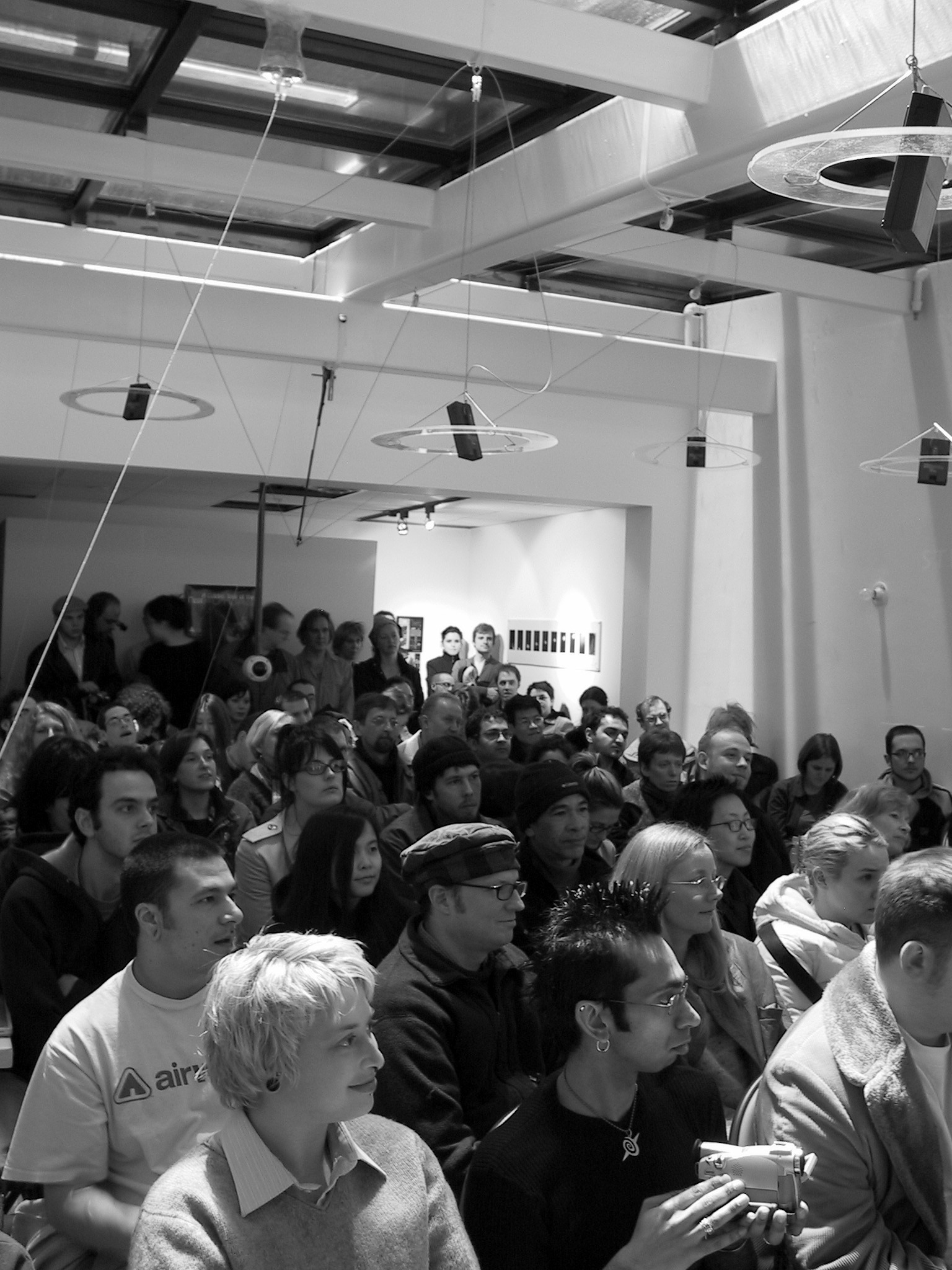
[Caption: DECONversation took place in the same space as
DECONcert was to take place the following evening.
The DECONcert Hall is equipped with a network of
electrodes that can be lowered down upon the audience by way
of remote control. This picture was taken after dark
on a dreary dismal rainy evening.]
The lighting in this space consisted of "natural artificial" light
produced by an array of aircraft landing lights arranged to
provide collimated beams of light [Figure 2].
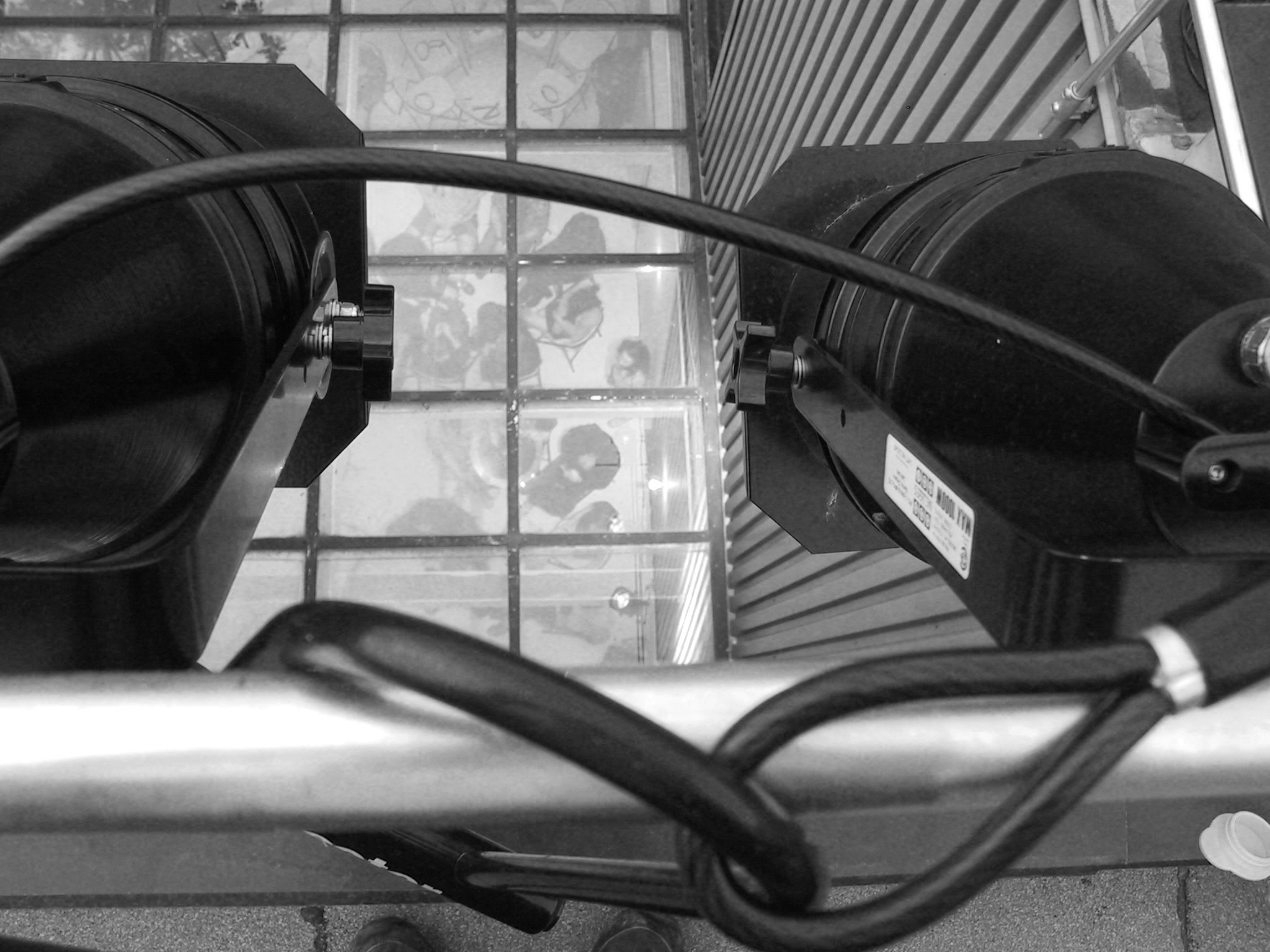
[Caption: Pictured here is our aluminum schedule 40, size 6 rig,
where we see a closeup of two of the nine MC Lights and the safety cable
(braided steel cable with plastic coating) that runs through
them in case they work loose.]
The lighting originally consisted of 12 aircraft landing lights and a 12
channel DMX 512 controller provided, on loan, by Jack Frost Lighting.
This setup was to allow for "artificial sunlight" to be "produced"
by brainwave action (amplified), but a large tarp was required to
protect the lights, so it did not make for a very permanent installation.
Subsequently MC Lights has manufactured, for this project,
nine weatherproof housings for our aircraft landing lights, so
that the installation can be more permanent.
The weatherproof housings eliminate the need for a large tarp
that would otherwise greatly increase the wind loading on the rig.
The MC Lights were first controlled by brainwaves on
an array of 1000 watt X10 IBM Leviton dimmers,
but these were replaced by a Microchip PIC
16F877 directly driving triacs through an opto isolator, using a new protocol
established by one of my students (Chris Aimone).
The lighting rig, designed and built by Chris Aimone,
Orion Gural, Vijai, and myself, is approximately
150 feet (approximately 46m) long, in total, and runs at a
height that is approximately
30 feet (approximately 9m) above the glass ceiling of the
DECONcert Hall. It also allows lights to be moved along / toward a
260 gallon chemical mixing vat used as the tub, as described later.
The concentration of light can approach and exceed the light
levels of natural sunlight.
On 2003, March 22, the DECONcert took place, in which audience
members participated in, created and defined, a
collective audiovisual biofeedback experience [Figure 3]
[Figure 4].
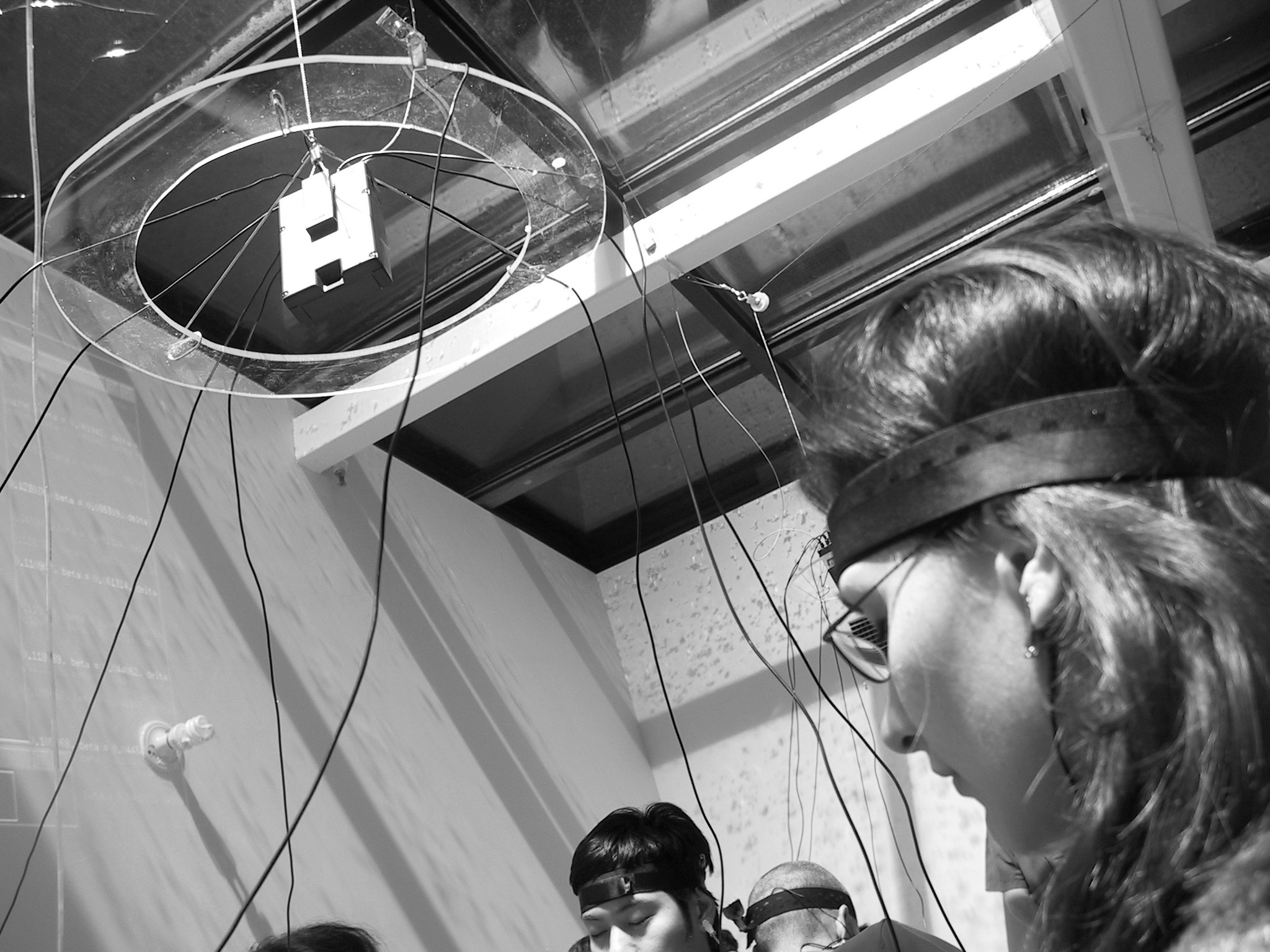
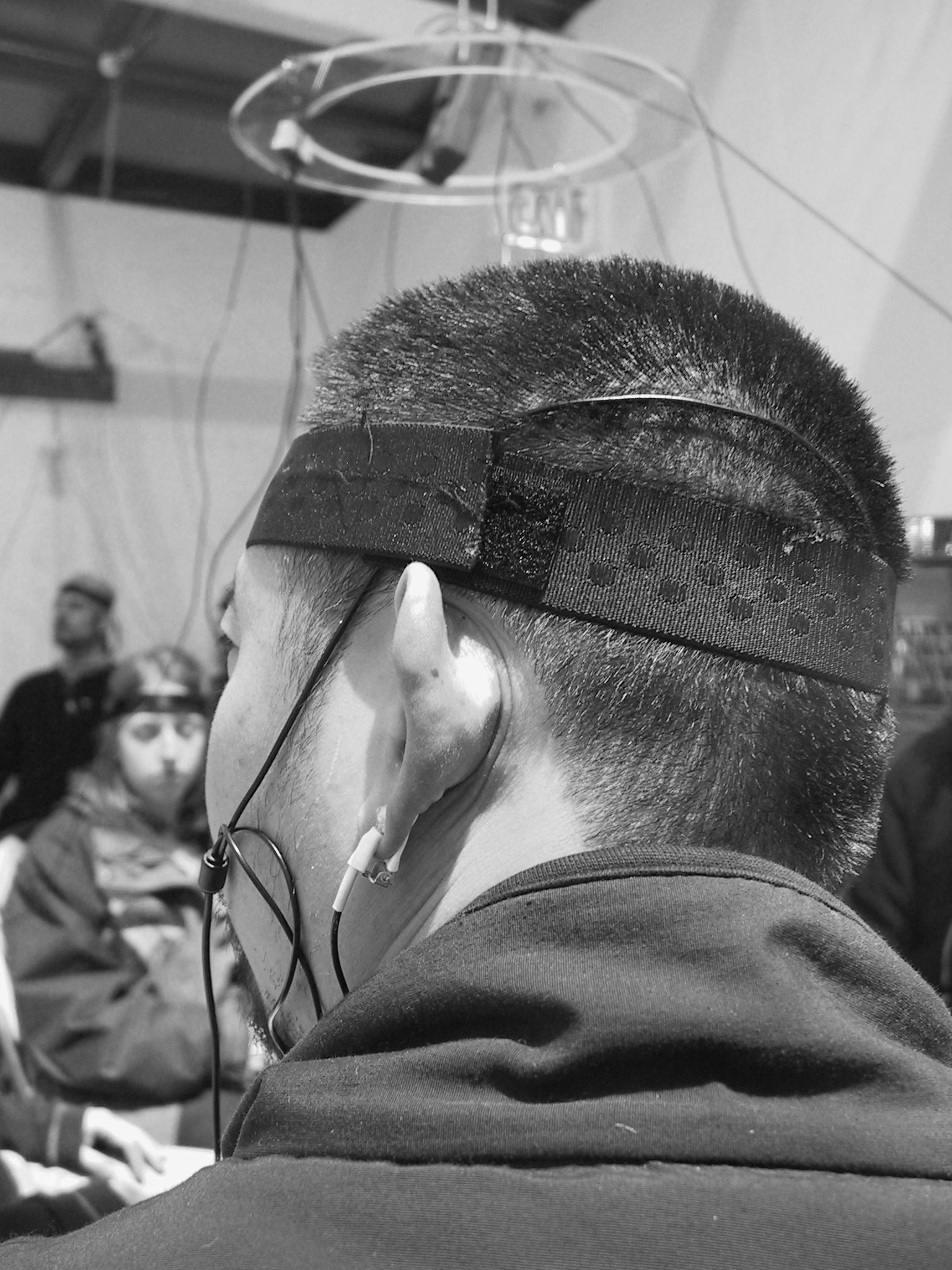
DECONcert proved to be a large success, with people lined up around the block
to get in. Thus we had to run three sessions in order to accommodate all
150 or so people (approximately 50 people per session).
From the various rehearsals, dress rehearsals, and followups of
DECONcert, as well as the DECONcert itself, we learned a great deal
about collective (de)consciousness, on various levels, both
practical and philosophical. On the practical level, we found it
was necessary to get people to relax in order to get good EEG signals.
The signals were taken from the
occipital lobe (located in the back of the brain,
i.e. posterior area of each cerebral hemisphere,
corresponding to the area of the brain used in visuospatial processing,
discrimination of optical flow, etc.).
Initially we had a cacophony of many "voices", some not so clean.
It was difficult to manage a large number of participants and to keep
everyone's brainwave signals simultaneously free of contamination.
I proposed a relaxation incentive, in which, for example, the group with
the strongest alpha waves (relaxed state) would "take control"
and be in the spotlight, and they would then get "stage fright"
or get nervous, and lose control. In this way, those who tried too
hard would not succeed in getting control, whereas those who
just relaxed and let it happen, would get control.
Thus it becomes a competition in trying not to compete.
Additionally, it was felt that a large communal
hot tub might help audience members relax
(or make them hysterical, through the part of the brain
responsible for the "fear of being seen in a bathing suit",
and thus challenge them to relax).
I had proposed the concept of a Telematic Tub, and had put out a message
calling for others to set up sister nodes, linked in to our tub,
to provide an immersive/underwater VR experience in which others would bathe
in water at the same temperature, wave state, etc., and share
in an audiovisual experience.
We indicated our tub's water temperature, as well as the wave
states (status of the jacuzzi jets, etc.) to enable others to
adjust their water temperature and wave patterns to match ours.
We also supplied live video feed from our tub's webcams.
I designed and built a three phase electrical distribution
panel, so that the tub, and all of the equipment it needed,
could be powered from an L21-30 receptacle. This made the
system interoperable, and movable.
In order to accommodate the wiring, we designed and built a raised
floor, from cedar planks, so that low voltage wiring, low
voltage data projectors, and other lighting could easily be run
underneath the tub whenever desired.
The tub itself was a 260 gallon chemical mixing vat provided by Unifuse.
Orion Gural and myself integrated the chemical mixing vat into an
immersive multimedia environment having four jacuzzi jets, five cameras,
and six projectors.
[Figure 5]
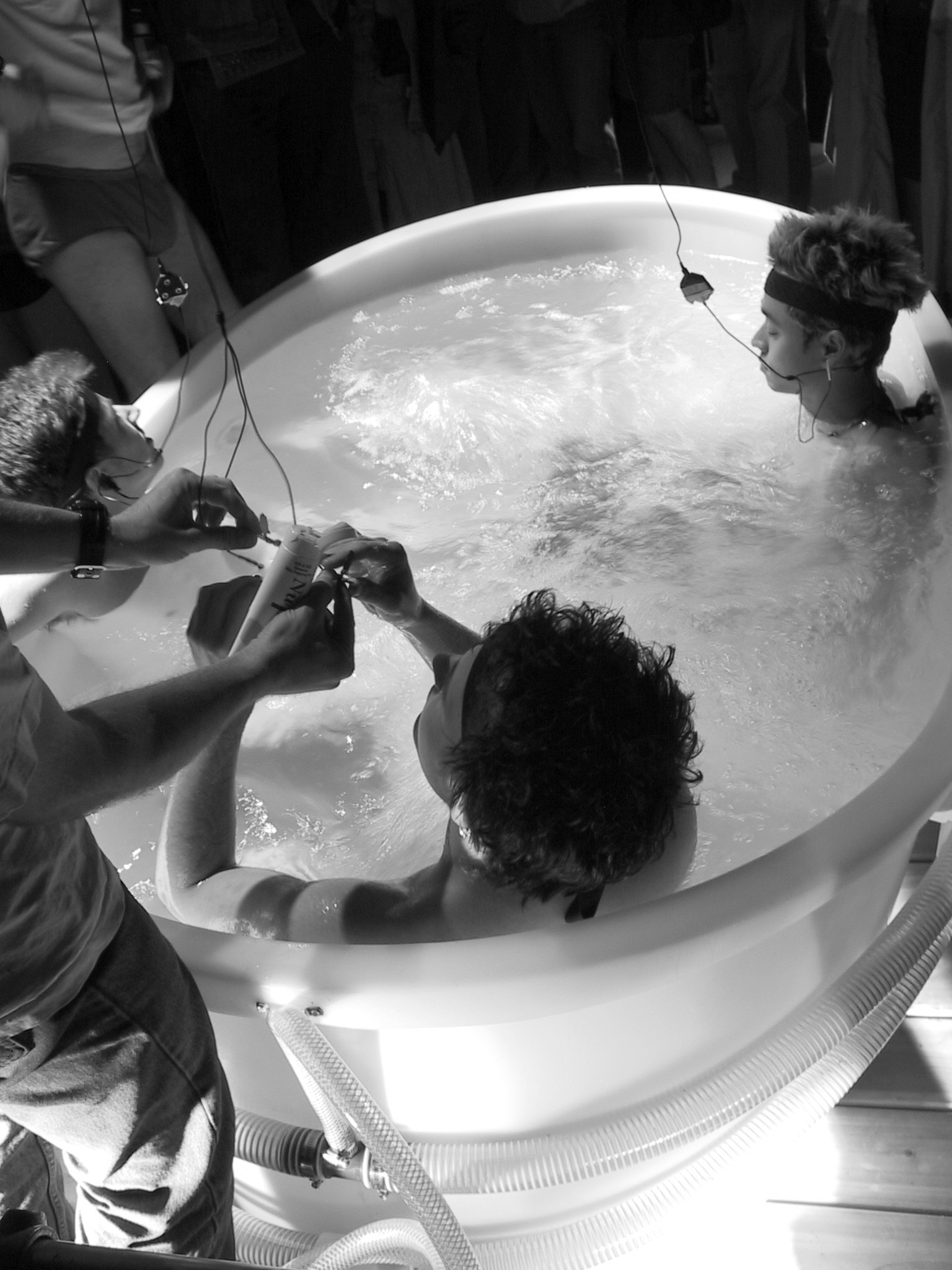
[Caption: Telematic Tub equipped with temperature regulator,
water pump, air jets, EEG sensors, and webcams. The translucent
sides and bottom of the tub make excellent underwater VR / multimedia
projection surfaces,
thus allowing high voltage projectors to be kept far away from the tub.]
In this way, people around the world could bathe together,
and with Toronto under SARS fears, bathers could be "communal
across the Internet without the risk of being communicable".
We chose to combine a Telematic Tubs event
with the opening of the Simon Penny/Bill Vorn exhibit
"Bedlam Telekinesis"
(May 23 - June 7, 2003)
also being held at the 330 Dundas Street location,
Opening Reception: Thursday May 22nd, 9-11pm.
Simon Penny and myself, together with philosopher Ronald de Sousa
and Derrick de Kerckhove (director of the McLuhan Program in Culture and
Technology), provided an opening context for Telematic Tubs,
which was also the opening Keynote Address for the
Subtle Technologies conference.
For this panel discussion, I suggested the idea that the panelists
could sit at the back of the room, off in some irrelevant corner,
and have a wall of televisions and loudspeakers at the front of the
room. Thus we arranged all the audience chairs to be facing away from
us, and toward our televisual representation. Using a quad
split-screen (a kind-of "surveillance aesthetic") the audience
experienced us remotely, as if we were presenting by way of
Visual Vicarious Soliloquy [12]. In this way the audience was forced
to "be us" rather than see us.
This stripped the audience of the usual eye-contact modality of
discourse, but gave them the chance to "get inside our heads".
Another television displayed a quad signal from Chris Aimone,
Orion Gural, Rosco Hill, and myself. Four cyborgs and four panelists,
presented as a wall of images.
The panel discussion probed the issues of simulation and simulacra,
at the cyborg/post-cyborg boundary, setting an appropriate context
for Telematic Tubs.
Those who wished to participate had been informed to BYOBAT
(Bring Your Own Bathingsuit And Towel).
Participating, of course,
involves a stripping off of our cyborg prostheses (clothing,
eyeglasses, wearable computers, etc.), and then re-connecting
in a collective (de)consciousness.
(In this case, it was a matter of connecting brainwave electrodes for the
generation of regenerative jazz.)
Two of my PhD students, James Fung, and Corey Manders are jazz musicians.
[Figure 6, or color plate if color plate is possible]


[Caption: The Fung Manders band; Corey Manders with soprano saxophone,
and James Fung on piano.]
Manders once made his living being a professional
saxophone player, prior to his returning to school.
Thus it seemed logical for Fung, a piano player, and Manders,
to somehow direct a collective participatory musical experience,
rather than merely having the audience generate sounds entirely
of their own accord, as in DECONcert.
Under their direction, the brainwave bath gave rise to a new kind of
immersive audiovisual experience.
Additionally, sister nodes could pop up on our data projectors,
to add visually communal bathing, connected over the Internet.
[Figure 7]
[Figure 8]

[Caption: Another participating washnode, 500 College Street,
2003 May 22. An eight channel EEG system is suspended from a pipe
screwed to a wooden beam.]
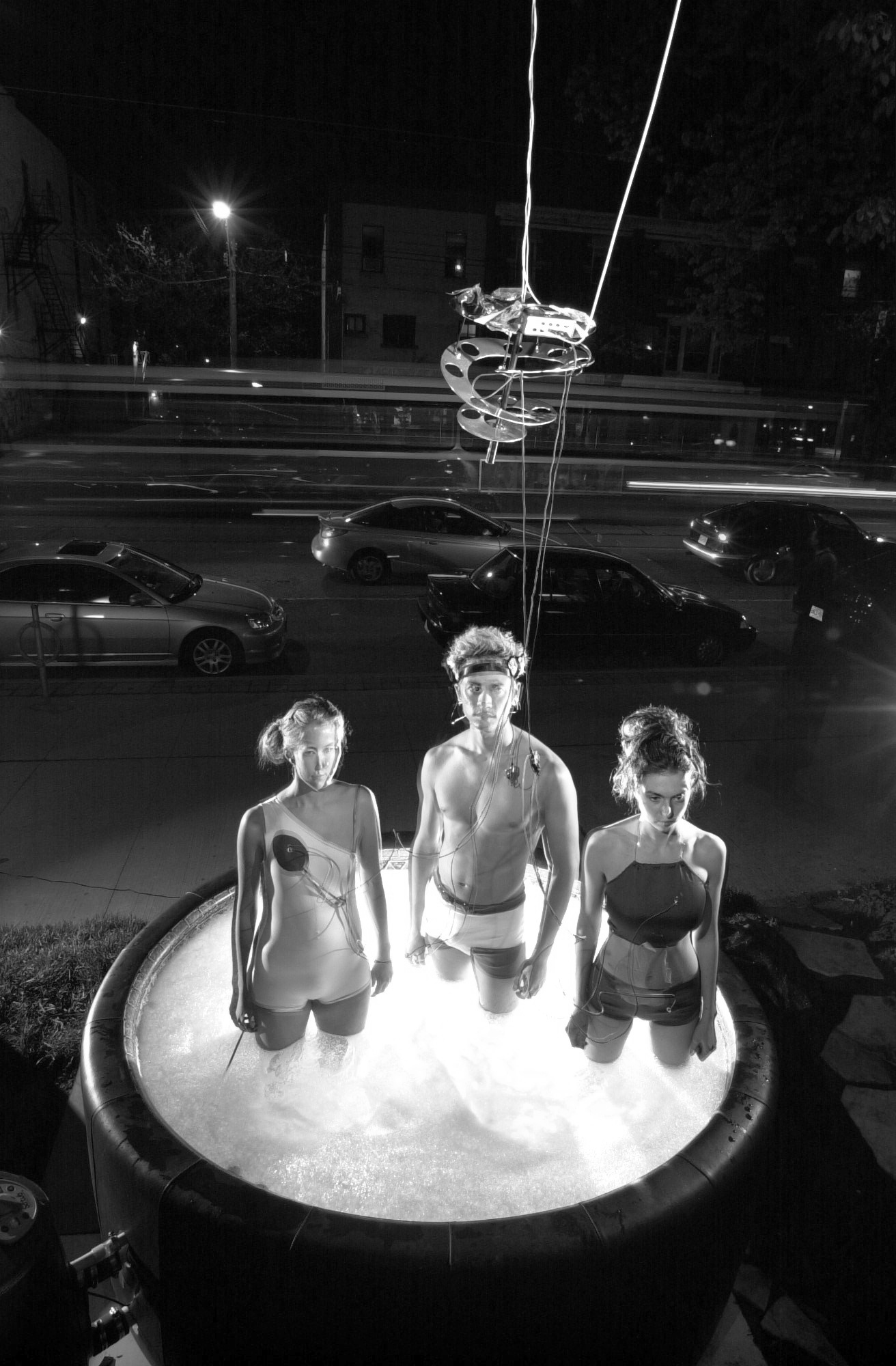
[Caption: The following evening, 2003 May 23, three participants wire up
for a brainwave bath.]
Visual Arousal Indicator
On 2003, May 29, we had DECONcert2, in which the brainwaves of
participants were used to modify various parameters of an
electronic saxophone (Manders) and piano (Fung). [Figure 9] [Figure 10]
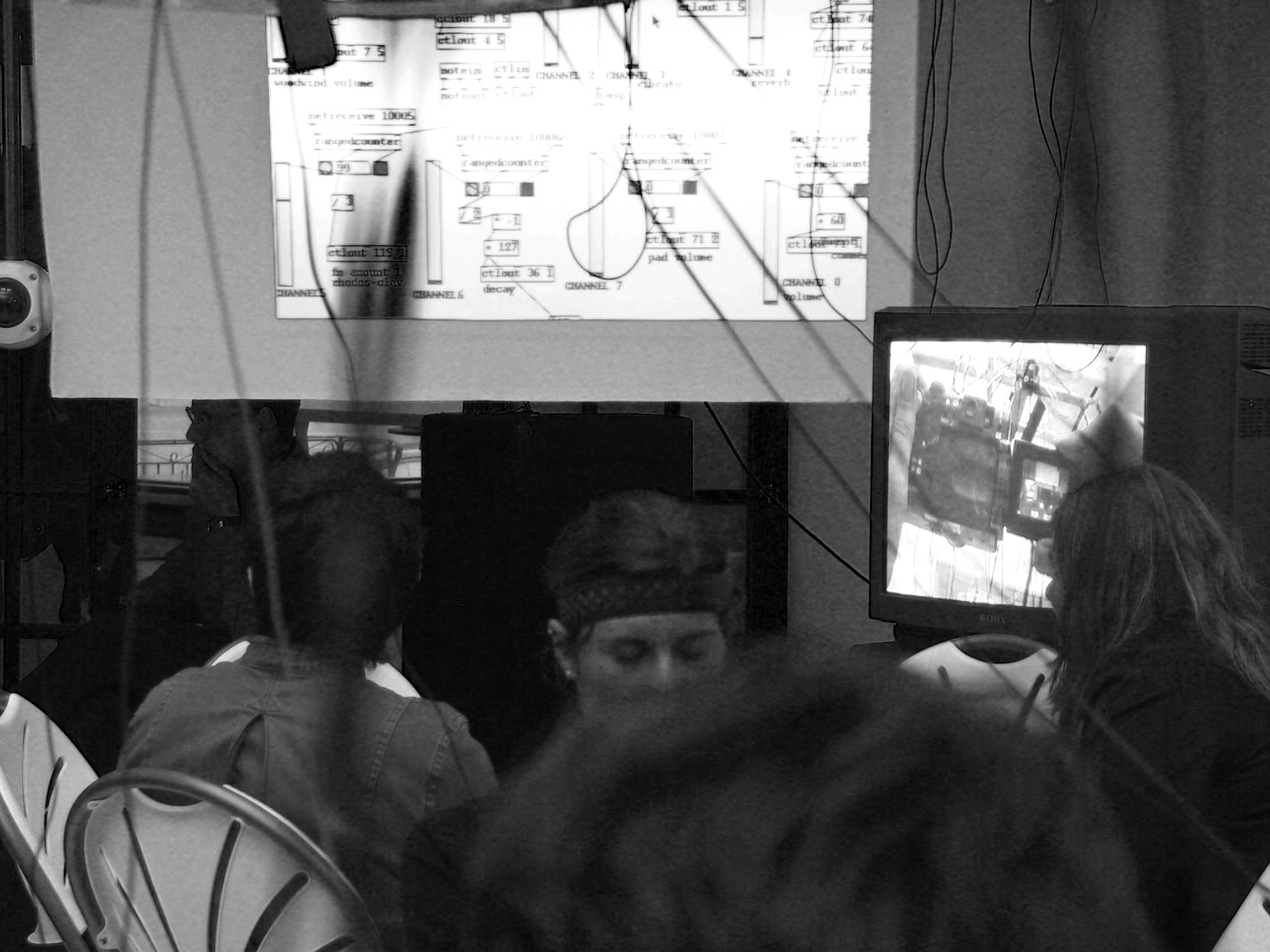
[Caption: Brainwave jazz parameters as displayed on a rear projection display.]
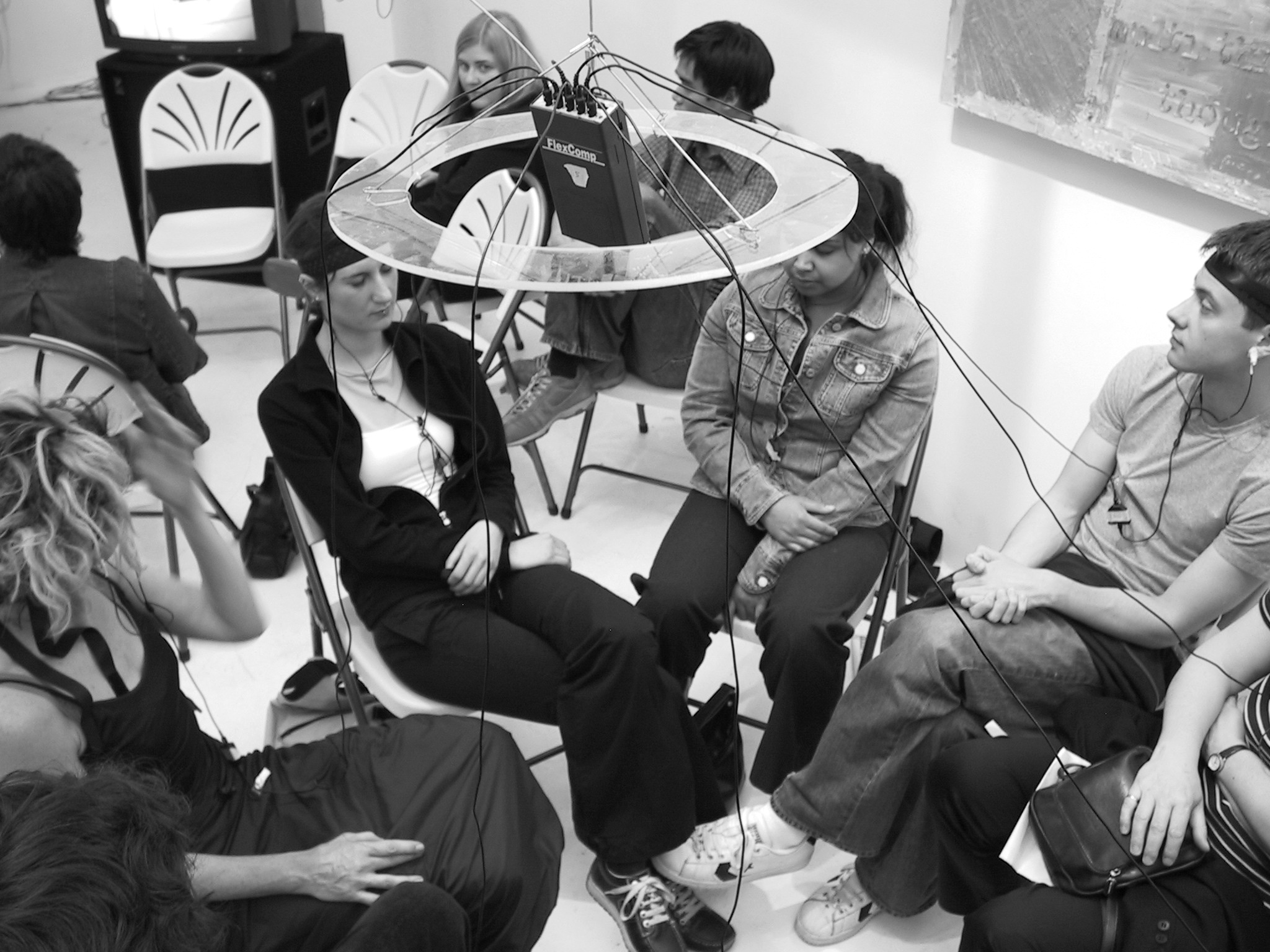
[Caption: Brainwave jazz parameters performance, 2003 May 29.]
After the brainwave jazz performance, attendees were invited to
participate in a much different kind of telematic bathing experience.
This time each person was connected to drive a separate aircraft landing
light directed at them. A computer system was programmed to
indicate visual arousal. Thus ignoring visual input causes the light to
dim, whereas visual arousal causes the light to brighten.
[Figure 11]
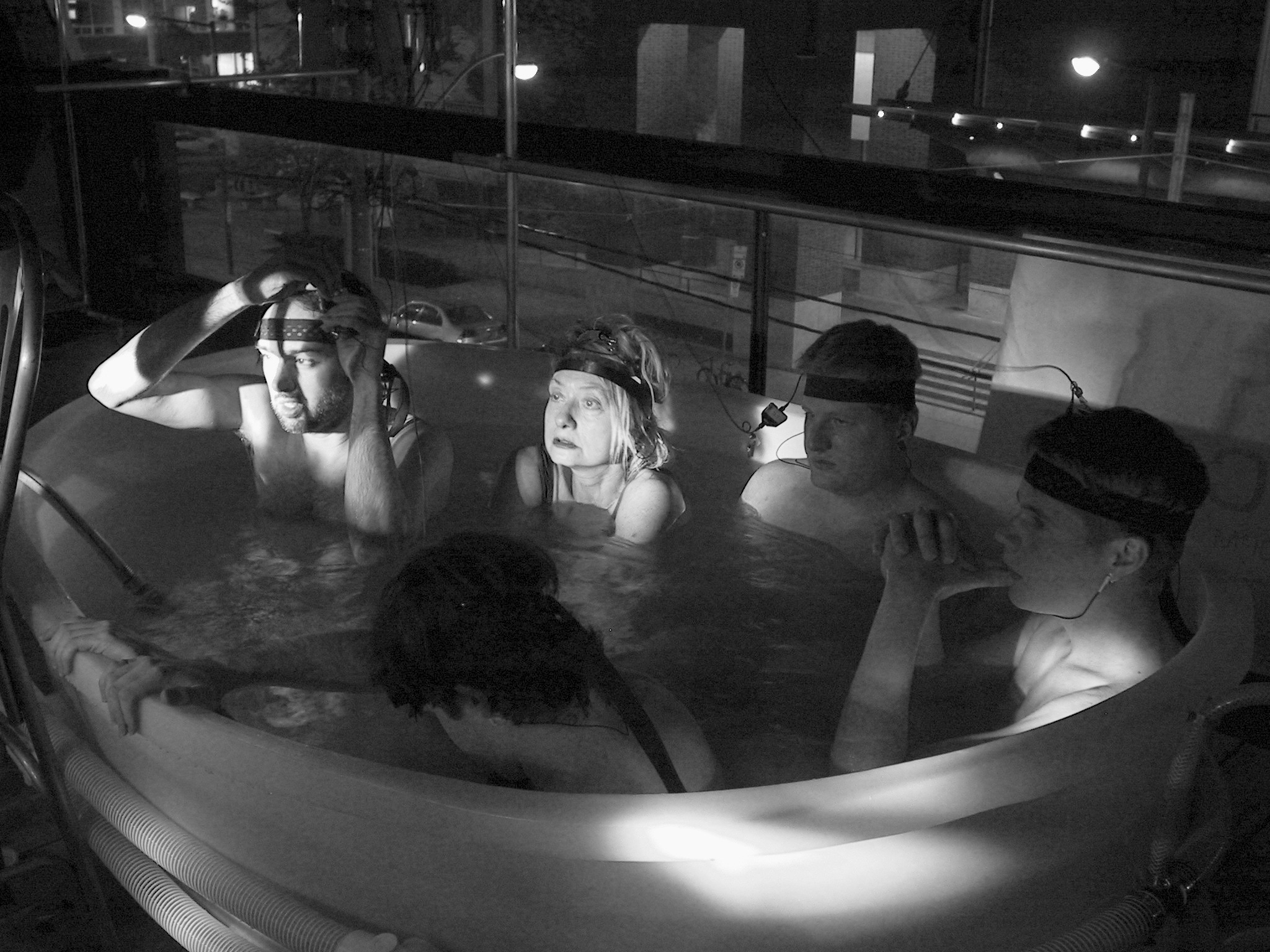
[Caption: Visual Arousal Indicators: There is one light for each bather,
controlled by that bather's brainwaves.]
Thus the public bath, which already challenges the notion of physical
privacy of the body, now takes on the role of challenging the
privacy of the mind.
In the communal bath, we try to pretend we are not looking at anything
in particular, but with the Visual Arousal Indicator we begin to
wonder to what extent our thoughts and intentions are broadcast
to others in the tub, as well as to others on the Internet, possibly at
other wash nodes.
Conclusions
Telematic Tubs strips the bather of their prosthetic shell,
and probes both the mind and the body. Telematic Tubs
turns the clothed (concealed) individual into a revealed element of
a collective (de)consciousness, assimilated into its
immersive medium of water and brainwaves.
Does Telematic Tubs point to a future that's free of terrorism,
free of contraband, free of contamination, and free of liberty?
Or does it suggest what might rise from the ashes of the Post-Cyborg Age.
Acknowledgements
I would like to acknowledge Canada Council for the Arts,
Ontario Arts Council, Toronto Arts Council, Thought Technology Ltd.,
Unifuse, Jack Frost Lighting, MC Lights, Samsung Electronics Canada,
and Yorkville Audio.
Moreover, I'd also like to acknowledge the help of my students,
and others, who made this work possible, including but not limited to:
James Fung and Corey Manders (musical talent, etc.),
Chris Aimone and Orion Gural (electromechanical, electrode sculpture,
tub rigging, etc.), Ariel Garten (design of bathing suits),
Stewart Morgan (curatorial), Michelle and Rosco Hill (curatorial assistance),
and David Elliott (project coordination), as well as the McLuhan
Program (Derrick de Kerckhove and Mark Federman).
References and Notes
- [1] Intelligent Bathroom Fixtures and Systems: EXISTech Corporation's
Safebath Project, by Steve Mann, Leonardo, Volume 36, Number 3.
- [2] Water/Wet/Liquid/Fluid-HCI/UI interactive closed-loop
mass-decontamination facility, DECONference 2002 September 11th.
- [3] Warning over chemical attack 'cordon'
Police 'might shoot' to stop contaminated victims
By Jimmy Burns in Blackpool
Published: May 14 2003 5:00
The Financial Times Ltd 2003.
http://news.ft.com
cached in http://wearcam.org/decon/police_shoot_to_maintain_decon_cordon.htm
- [4] Sun.Star Zamboanga: Floating Quarantine station okay? (p1 of 5)
Editorial: Sars out of control Floating Quarantine station okay?
By Lino Santos
Saturday, May 03, 2003
- [5] abc27
Beijing Builds 1,000-Bed SARS Hospital
Wednesday April 30, 2003 8:55pm
Cached in
http://wearcam.org/decon/sars/hospital_ringed_by15foot_wall.htm
The New York Times (April 27, 2003)
also notes that in the "hospital",
"Single rooms are just large enough for a bed and a toilet,
and they are arranged in rows divided by semienclosed corridors that
circulate fresh air."
(Cached in sars/sars_compound_semienclosed_corridor.htm)
If one were not informed that this were a
hospital, one might wonder, what other kind of building
is enclosed by a high wall, with guards, and has
rows of rooms just large enough for a bed and toilet, each having
a slot in which to insert food.
- [6] Taipei rounds up homeless in Wanhua
Relocating indigents seen as necessary precaution to stemming tide of
SARS in city, 2003-05-13, Taiwan News, By Hung-fu Hsueh, Staff Reporter
- [7] "Now, we do not need in this case to quarantine the whole
family, because we want to quarantine only those people who have early
indications of the illness and we catch them, ...
ask people who have the symptoms to join us at the most
luxurious beach resort we can find, around which we are going to throw
a ten-foot wall, reinforced by guards with nonviolent means of
stopping people who want to leave."
Public Health in the Age of Bioterrorism,
The Communitarian NETWORK For Individual Rights and Responsibility,
Volume 12, Issue 2, Spring 2002,
www.gwu.edu/~ccps/rcq/rcq_public_health.html
- [8] Loyang chalets to become alternative SARS quarantine site
By Bridgette See
2003 MCN International Pte Ltd
Cached in http://wearcam.org/decon/sars/sars_beach_resort_first_quarantine_camp_in_singapore.htm
- [9] The Post-Cyborg Path to Deconism, Steve Mann,
Ctheory, 2003 Feb. 18.
For various previous draft versions,
see also http://wearcam.org/ctheory/
- [10] DECONversation: Robotic Body meets Cyborg Mind.
An evening of discussion between Stelarc and Mann.
2003 Mar 21, 7pm, Deconism Gallery/Museum/Arts Complex,
330 Dundas Street West.
Moderated by Mark Federman, Chief Strategist of the McLuhan Program in
Culture and Technology. See http://wearcam.org/deconversation
- [11] "Cyborg Echoes,
History and Future of Wearable Computing",
2003 Mar 21-31, Deconism Gallery/Museum/Arts Complex,
330 Dundas Street West.
See http://wearcam.org/dusting/cyborg_echoes/vindex.htm
- [12] Visual Vicarious Soliloquy is a form of remote presentation
by way of giving an existential presentation using EyeTap eyeglasses,
as described in "CYBORG: Digital Destiny and Human Possibility in the
Age of the Wearable Computer", Steve Mann with Hal Niedzviecki,
Doubleday, 2001. ISBN: 0385658257 (Hardcover).















